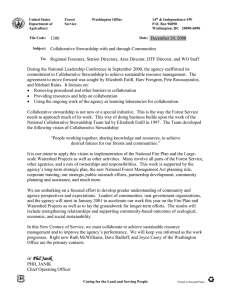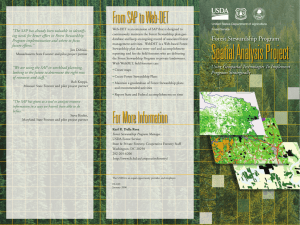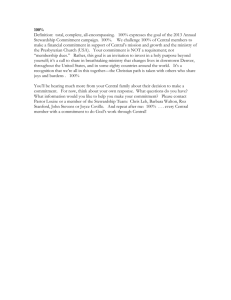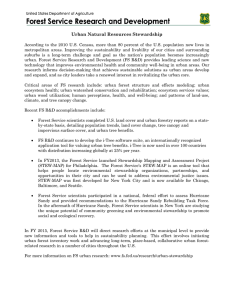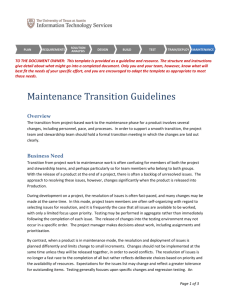Spatial Analysis Project (SAP) Map #2 Update Guidance
advertisement
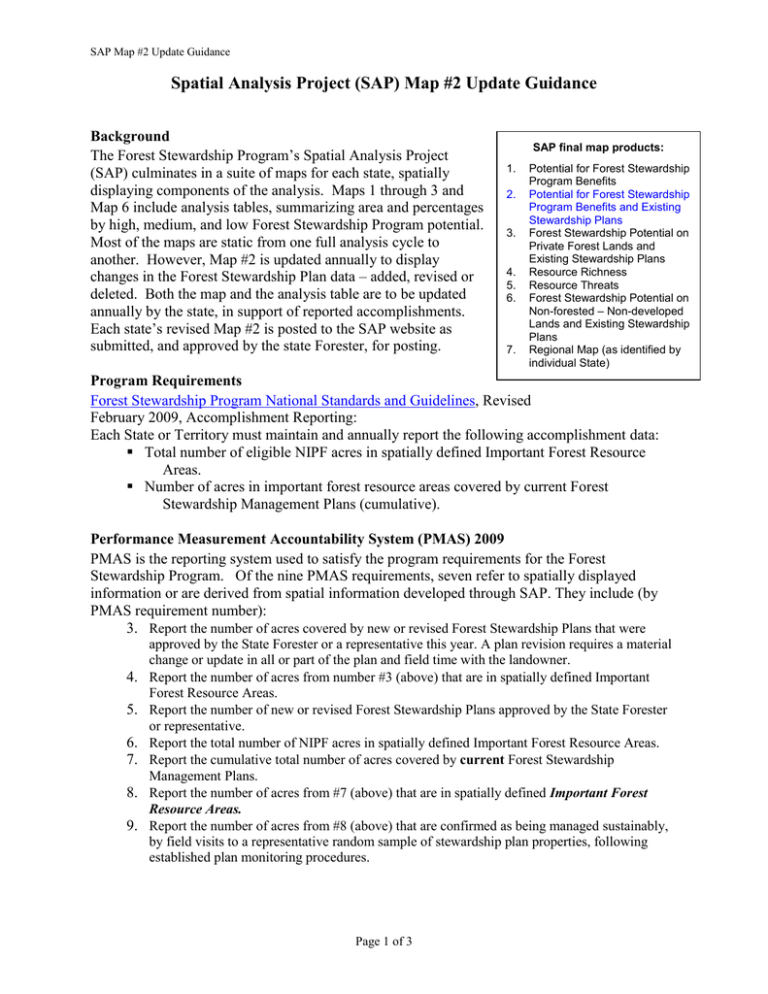
SAP Map #2 Update Guidance Spatial Analysis Project (SAP) Map #2 Update Guidance Background The Forest Stewardship Program’s Spatial Analysis Project (SAP) culminates in a suite of maps for each state, spatially displaying components of the analysis. Maps 1 through 3 and Map 6 include analysis tables, summarizing area and percentages by high, medium, and low Forest Stewardship Program potential. Most of the maps are static from one full analysis cycle to another. However, Map #2 is updated annually to display changes in the Forest Stewardship Plan data – added, revised or deleted. Both the map and the analysis table are to be updated annually by the state, in support of reported accomplishments. Each state’s revised Map #2 is posted to the SAP website as submitted, and approved by the state Forester, for posting. SAP final map products: 1. 2. 3. 4. 5. 6. 7. Potential for Forest Stewardship Program Benefits Potential for Forest Stewardship Program Benefits and Existing Stewardship Plans Forest Stewardship Potential on Private Forest Lands and Existing Stewardship Plans Resource Richness Resource Threats Forest Stewardship Potential on Non-forested – Non-developed Lands and Existing Stewardship Plans Regional Map (as identified by individual State) Program Requirements Forest Stewardship Program National Standards and Guidelines, Revised February 2009, Accomplishment Reporting: Each State or Territory must maintain and annually report the following accomplishment data: Total number of eligible NIPF acres in spatially defined Important Forest Resource Areas. Number of acres in important forest resource areas covered by current Forest Stewardship Management Plans (cumulative). Performance Measurement Accountability System (PMAS) 2009 PMAS is the reporting system used to satisfy the program requirements for the Forest Stewardship Program. Of the nine PMAS requirements, seven refer to spatially displayed information or are derived from spatial information developed through SAP. They include (by PMAS requirement number): 3. Report the number of acres covered by new or revised Forest Stewardship Plans that were 4. 5. 6. 7. 8. 9. approved by the State Forester or a representative this year. A plan revision requires a material change or update in all or part of the plan and field time with the landowner. Report the number of acres from number #3 (above) that are in spatially defined Important Forest Resource Areas. Report the number of new or revised Forest Stewardship Plans approved by the State Forester or representative. Report the total number of NIPF acres in spatially defined Important Forest Resource Areas. Report the cumulative total number of acres covered by current Forest Stewardship Management Plans. Report the number of acres from #7 (above) that are in spatially defined Important Forest Resource Areas. Report the number of acres from #8 (above) that are confirmed as being managed sustainably, by field visits to a representative random sample of stewardship plan properties, following established plan monitoring procedures. Page 1 of 3 SAP Map #2 Update Guidance Supplemental Instructions – PMAS 2009 Reporting Forest Stewardship Program and Rural Forestry Assistance States must maintain spatial record of all current Forest Stewardship Plans and associated acres. For plans written before October 2005, that do not specify start and end dates, states should consider all plans five or less years old to be current. Important Forest Resource Areas These are the areas that are considered to be of high program potential as a result of a state’s Spatial Analysis Project (SAP) assessment. These areas can either be defined simply as SAP generated high priority pixels on the landscape, or by aggregating high priority pixels and summarizing to create a landscape scale delineation such as a watershed, a fire shed, or a wildland-urban interface area. Map #2 Guidance (refer to Map #2 template) Four performance measures identified in PMAS (elements 4, 6, 8, and 9) address Important Forest Resource Areas, as defined as HIGH Potential (darkest green on map) for Forest Stewardship Benefit, resulting from the Forest Stewardship Program Spatial Analysis Project (SAP). Refer to the Map Template for placement of Titles, Tables as appropriate, Logos – State and Federal, etc. Label map in BLACK in the upper left corner with the Map number (2) Area EXCLUDED from analysis (Areas without Stewardship Potential) is WHITE and is comprised of (1) Developed areas (MRLC categories 21, 22, 23, and 32) (2) Public Lands (3) Surface Water Area INCLUDED in Analysis, but not covered by primary themes in the maps is in light gray. Legends and Table Backgrounds: Solid light gray In the legend, the order of all ramped colors (greens for Stewardship Potential, orange for Threats) is: “Low” at the top, “Medium” in the middle and “High” at the bottom. Stewardship Plan Locations: Should be depicted as polygons, not centroids (unless otherwise agreed upon). Legend text should refer to ‘Stewardship Plans’ (not ‘Properties’). Adjacent States, Nations, and Waters: The area surrounding the State Maps should be displayed as follows: Adjacent “other” states: beige o Ocean or other open adjacent water: light blue o Adjacent nations (specifically Canada and Mexico): same beige as adjacent states, with a heavier (thicker) black line separating nations, than the black line separating states. Map Title: Potential for Forest Stewardship Program Benefits and Existing Stewardship Plans [State Name] Page 2 of 3 SAP Map #2 Update Guidance Tables and Legend Background: [refer to Stewardship Style Sheet] Light Gray Legend: Legend Title: Stewardship Potential Color: Ramping green for Low / Medium / High White: Areas without Stewardship potential Black: Existing Forest Stewardship Plans. Red: Current Year Forest Stewardship Plans (new or revised) Move second column of boxes to the RIGHT so as not to be placed directly below Stewardship Potential. Tables: Map #2 Delivery: When complete, notify Tom Luther by e-mail tluther@fs.fed.us with a cc to the appropriate regional Forest Service, Forest Stewardship Program coordinator, that Map #2 is ready for submission and posting. Tom will provide the ftp link. At a minimum, all states will spatially display and quantify current year plans (new and revised). If changes have been made to the SAP Potential (High, Medium, Low) composite dataset, the state will need to provide a ESRI grid layer and updated methodology document, or addendum to existing methodology, explaining the need for the update. Page 3 of 3
